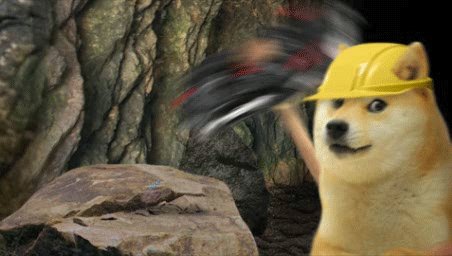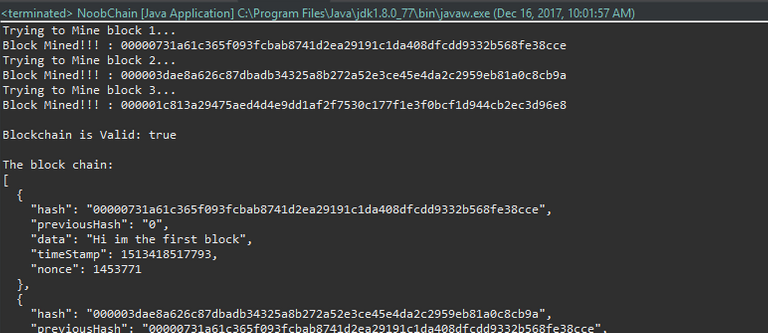Creating Your First Blockchain with Java. Part 1.
Note: I initially posted this tutorial on Medium, but thought It might interest some people on here :)
In this tutorial we will :
- Create your first (very) basic ‘blockchain’.
- Implement a simple proof of work ( mining ) system.
- Marvel at the possibilities.
( I will assume you have a basic understanding of Object Oriented Programming )
It’s worth noting that this wont be a fully functioning, ready for production block chain. Instead this is a proof of concept implementation to help you understand what a blockchain is for future tutorials.
Setting Up.
We will be using Java but you should be able to follow along in any OOP language. I’ll be using Eclipse but you can use any new fancy text editor ( though you’ll miss out on a lot of good bloat ).
You will need:
- Java and JDK installed. ( duh ).
- Eclipse ( or another IDE/Text Editor ).

Don’t worry if your eclipse looks different to mine. I’ll be using a dark theme in eclipse because ^
Optionally, you can grab GSON library by google (who are they ???). This will allow us to turn an object into Json \o/. It’s a super useful library that we will also be using further down the line for peer2peer stuff, but feel free to use an alternate method.
In Eclipse create a (file > new > ) Java project. I’ll call my Project “noobchain” and create a new Class by the same name (NoobChain).

Don’t be copying my project name now ( ͠° ͟ ͜ʖ ͡°)
Now you’re good to go :)
Making the Blockchain.
A blockchain is just a chain/list of blocks. Each block in the blockchain will have its own digital signature, contain digital signature of the previous block, and have some data ( this data could be transactions for example ).

I sure hope Nakamoto never sees this.
Hash = Digital Signature.
Each block doesn’t just contain the hash of the block before it, but its own hash is in part, calculated from the previous hash. If the previous block’s data is changed then the previous block’s hash will change ( since it is calculated in part, by the data) in turn affecting all the hashes of the blocks there after. Calculating and comparing the hashes allow us to see if a blockchain is invalid.
What does this mean ? …Changing any data in this list, will change the signature and break the chain.
So Firsts lets create class Block that make up the blockchain:
import java.util.Date;
public class Block {
public String hash;
public String previousHash;
private String data; //our data will be a simple message.
private long timeStamp; //as number of milliseconds since 1/1/1970.
//Block Constructor.
public Block(String data,String previousHash ) {
this.data = data;
this.previousHash = previousHash;
this.timeStamp = new Date().getTime();
}
}
As you can see our basic Block contains a String hash that will hold our digital signature. The variable previousHash to hold the previous block’s hash andString data to hold our block data.
Next we will need a way to generate a digital signature,
there are many cryptographic algorithms you can choose from, however SHA256 fits just fine for this example. We can import java.security.MessageDigest; to get access to the SHA256 algorithm.
We need to use SHA256 later down the line so lets create a handy helper method in a new StringUtil ‘utility’ class :
import java.security.MessageDigest;
public class StringUtil {
//Applies Sha256 to a string and returns the result.
public static String applySha256(String input){
try {
MessageDigest digest = MessageDigest.getInstance("SHA-256");
//Applies sha256 to our input,
byte[] hash = digest.digest(input.getBytes("UTF-8"));
StringBuffer hexString = new StringBuffer(); // This will contain hash as hexidecimal
for (int i = 0; i < hash.length; i++) {
String hex = Integer.toHexString(0xff & hash[i]);
if(hex.length() == 1) hexString.append('0');
hexString.append(hex);
}
return hexString.toString();
}
catch(Exception e) {
throw new RuntimeException(e);
}
}
}
http://www.baeldung.com/sha-256-hashing-java
Don’t worry too much if you don’t understand the contents of this helper method, all you need to know is that it takes a string and applies SHA256 algorithm to it, and returns the generated signature as a string.
Now lets use our applySha256 helper, in a new method in the Block class, to calculate the hash. We must calculate the hash from all parts of the block we don’t want to be tampered with. So for our block we will include the previousHash, the data and timeStamp.
public String calculateHash() {
String calculatedhash = StringUtil.applySha256(
previousHash +
Long.toString(timeStamp) +
data
);
return calculatedhash;
}
and lets add this method to the Block constructor…
public Block(String data,String previousHash ) {
this.data = data;
this.previousHash = previousHash;
this.timeStamp = new Date().getTime();
this.hash = calculateHash(); //Making sure we do this after we set the other values.
}
Time for some testing…
In our main NoobChain class lets create some blocks and print the hashes to the screen to see that everything is in working order.

Lets test this…
The first block is called the genesis block, and because there is no previous block we will just enter “0” as the previous hash.
public class NoobChain {
public static void main(String[] args) {
Block genesisBlock = new Block("Hi im the first block", "0");
System.out.println("Hash for block 1 : " + genesisBlock.hash);
Block secondBlock = new Block("Yo im the second block",genesisBlock.hash);
System.out.println("Hash for block 2 : " + secondBlock.hash);
Block thirdBlock = new Block("Hey im the third block",secondBlock.hash);
System.out.println("Hash for block 3 : " + thirdBlock.hash);
}
}
The output should look similar to this:

Your values will be different because your timestamp will be different.
Each block now has its own digital signature based on its information and the signature of the previous block.
Currently it’s not much of a blockchain, so lets store our blocks in an ArrayList and also import gson to view it as Json. (click here to find out how to import the gson library)
import java.util.ArrayList;
import com.google.gson.GsonBuilder;
public class NoobChain {
public static ArrayList<Block> blockchain = new ArrayList<Block>();
public static void main(String[] args) {
//add our blocks to the blockchain ArrayList:
blockchain.add(new Block("Hi im the first block", "0"));
blockchain.add(new Block("Yo im the second block",blockchain.get(blockchain.size()-1).hash));
blockchain.add(new Block("Hey im the third block",blockchain.get(blockchain.size()-1).hash));
String blockchainJson = new GsonBuilder().setPrettyPrinting().create().toJson(blockchain);
System.out.println(blockchainJson);
}
}
Now our output should look something closer to what we expect a blockchain to look like.
Now we need a way to check the integrity of our blockchain.
Lets create an isChainValid() Boolean method in the NoobChain class, that will loop through all blocks in the chain and compare the hashes. This method will need to check the hash variable is actually equal to the calculated hash, and the previous block’s hash is equal to the previousHash variable.
Block currentBlock;
Block previousBlock;
//loop through blockchain to check hashes:
for(int i=1; i < blockchain.size(); i++) {
currentBlock = blockchain.get(i);
previousBlock = blockchain.get(i-1);
//compare registered hash and calculated hash:
if(!currentBlock.hash.equals(currentBlock.calculateHash()) ){
System.out.println("Current Hashes not equal");
return false;
}
//compare previous hash and registered previous hash
if(!previousBlock.hash.equals(currentBlock.previousHash) ) {
System.out.println("Previous Hashes not equal");
return false;
}
}
return true;
}
Any change to the blockchain’s blocks will cause this method to return false.
On the bitcoin network nodes share their blockchains and the longest valid chain is accepted by the network. What’s to stop someone tampering with data in an old block then creating a whole new longer blockchain and presenting that to the network ? Proof of work. The hashcash proof of work system means it takes considerable time and
computational power to create new blocks. Hence the attacker would need more computational power than the rest of the peers combined.

hashcash, much wow.
Lets start mining blocks !!!
We will require miners to do proof-of-work by trying different variable values in the block until its hash starts with a certain number of 0’s.
Lets add an int called nonce to be included in our calculateHash() method, and the much needed mineBlock() method :
import java.util.Date;
public class Block {
public String hash;
public String previousHash;
private String data; //our data will be a simple message.
private long timeStamp; //as number of milliseconds since 1/1/1970.
private int nonce;
//Block Constructor.
public Block(String data,String previousHash ) {
this.data = data;
this.previousHash = previousHash;
this.timeStamp = new Date().getTime();
this.hash = calculateHash(); //Making sure we do this after we set the other values.
}
//Calculate new hash based on blocks contents
public String calculateHash() {
String calculatedhash = StringUtil.applySha256(
previousHash +
Long.toString(timeStamp) +
Integer.toString(nonce) +
data
);
return calculatedhash;
}
public void mineBlock(int difficulty) {
String target = new String(new char[difficulty]).replace('\0', '0'); //Create a string with difficulty * "0"
while(!hash.substring( 0, difficulty).equals(target)) {
nonce ++;
hash = calculateHash();
}
System.out.println("Block Mined!!! : " + hash);
}
}
The mineBlock() method takes in an int called difficulty, this is the number of 0’s they must solve for. Low difficulty like 1 or 2 can be solved nearly instantly on most computers, i’d suggest something around 4–6 for testing. At the time of writing Litecoin’s difficulty is around 442,592.
Lets add the difficulty as a static variable to the NoobChain class :
public static int difficulty = 5;
We should update the NoobChain class to trigger the mineBlock() method for each new block. The isChainValid() Boolean should also check if each block has a solved ( by mining ) hash.
import java.util.ArrayList;
import com.google.gson.GsonBuilder;
public class NoobChain {
public static ArrayList<Block> blockchain = new ArrayList<Block>();
public static int difficulty = 5;
public static void main(String[] args) {
//add our blocks to the blockchain ArrayList:
blockchain.add(new Block("Hi im the first block", "0"));
System.out.println("Trying to Mine block 1... ");
blockchain.get(0).mineBlock(difficulty);
blockchain.add(new Block("Yo im the second block",blockchain.get(blockchain.size()-1).hash));
System.out.println("Trying to Mine block 2... ");
blockchain.get(1).mineBlock(difficulty);
blockchain.add(new Block("Hey im the third block",blockchain.get(blockchain.size()-1).hash));
System.out.println("Trying to Mine block 3... ");
blockchain.get(2).mineBlock(difficulty);
System.out.println("\nBlockchain is Valid: " + isChainValid());
String blockchainJson = new GsonBuilder().setPrettyPrinting().create().toJson(blockchain);
System.out.println("\nThe block chain: ");
System.out.println(blockchainJson);
}
public static Boolean isChainValid() {
Block currentBlock;
Block previousBlock;
String hashTarget = new String(new char[difficulty]).replace('\0', '0');
//loop through blockchain to check hashes:
for(int i=1; i < blockchain.size(); i++) {
currentBlock = blockchain.get(i);
previousBlock = blockchain.get(i-1);
//compare registered hash and calculated hash:
if(!currentBlock.hash.equals(currentBlock.calculateHash()) ){
System.out.println("Current Hashes not equal");
return false;
}
//compare previous hash and registered previous hash
if(!previousBlock.hash.equals(currentBlock.previousHash) ) {
System.out.println("Previous Hashes not equal");
return false;
}
//check if hash is solved
if(!currentBlock.hash.substring( 0, difficulty).equals(hashTarget)) {
System.out.println("This block hasn't been mined");
return false;
}
}
return true;
}
}
Running this your results should look like :

Mining each block took some time! ( around 3 seconds ) You should mess around with the difficulty value to see how that effects the time it takes to mine each block ;)
If someone were to tamper😒 with the data in your blockchain system:
- Their blockchain would be invalid.
- They would not be able to create a longer blockchain.
- Honest blockchains in your network will have a time advantage on the longest
chain.
A tampered blockchain will not be able to catch up with a longer & valid chain.
*unless they have vastly more computation speed than all other nodes in your network combined. A future quantum computer or something.
You’re all done with your basic blockchain!

Go on pat yourself on the back.
Your blockchain:
- Is made up of blocks that store data.
- Has a digital signature that chains your blocks together.
- Requires proof of work mining to validate new blocks.
- Can be check to see if data in it is valid and unchanged.
You can download these project files on
Github.

You can follow to be notified when next tutorials and other blockchain development articles are posted. Any feedback is also greatly appreciated.
Thanks.
Creating Your First Blockchain with Java. Part 2:
(I will update this with a steemit link once I post the second part here :D ) We cover Transactions, Signatures and Wallets.
contact: [email protected]
hmm, I'm considering posting part 3 on steemit first, but It's really awkward to read the code with out syntax highlighting.
Hopefully we can get the ability to embed Gist soon.
I don't mind if you tweet it out in sections! I've been following along with this on medium. Really looking forward to part 3. Thanks for posting this!
Congratulations @kass! You have completed some achievement on Steemit and have been rewarded with new badge(s) :
Click on any badge to view your own Board of Honor on SteemitBoard.
For more information about SteemitBoard, click here
If you no longer want to receive notifications, reply to this comment with the word
STOPI always wanted to learn more avour creating a blockchain. Im giving you an upvote and follow. Keep them coming!
Hi! I am a robot. I just upvoted you! I found similar content that readers might be interested in:
https://medium.com/programmers-blockchain/create-simple-blockchain-java-tutorial-from-scratch-6eeed3cb03fa
The blockchain is really a revolutionary thing. It could be the Internet 2.0
Didn't realize you were on the site. Make sure you look at the link so cheetah doesn't get you flagged and blacklisted by other members.
https://steemit.com/steemit/@anyx/cheetah-bot-the-fight-against-spam-and-plagiarism-continues
A very interesting post @kass - thanks for sharing.
Thank You!
Thanks for the tutorial. As a java developer this helps a lot!!!